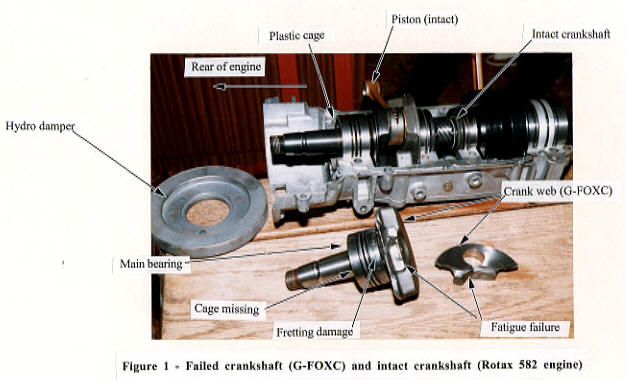The aircraft was flying from Perth to East
Fortune. As the aircraft was crossing the Firth of Forth, the
pilot (who was also the owner) noticed a smell of burning. He
immediately carried out a 180° turn to head back to land,
reducing power from 5,400 to 4,000 RPM and aimed for Sorbie
airfield. Descending through 3,700 feet the engine stopped
abruptly so the pilot selected a suitable field into which he
was able to perform a safe landing into wind, with no further
incident.
Examination after the landing showed that
the crankshaft had failed and had then penetrated the engine
casing. The engine was removed from the aircraft and, after
the engine was dismantled, the failed crankshaft items were
sent to the AAIB for further investigation (Figure
1 shows the failed item, next to an intact crankshaft from
a later Rotax 582 engine).
The failure was in the crank web adjacent
to the main bearing at the rear of the engine. The examination
of the fracture surfaces showed that there was clear evidence
of fatigue crack growth through the web material. The
initiation points were on the 'big end' side of the web, where
the forging had been machined to a flat surface with an abrupt
change of cross-section. It was also noted that there had been
considerable fretting damage to the main bearing. This damage
appeared to have been due to vibration and loads caused by the
loss of the plastic cages which hold the balls in their
correct relative positions within the two main bearing races.
The aircraft had been completed in 1991
and, up to the time of the accident, had accumulated some
96 hours with the same engine installed. This represents a
usage of some 10 hours per year, quite common in this category
of aircraft. In discussion with the UK agents for Rotax
engines, two mechanisms were discussed which might have led to
the failure of the plastic roller cages and thus to the
failure of the crank web.
One mechanism would have been the loss of
the plastic cages due to chemical contamination over a
sustained period. The Rotax 582 is a two cylinder 2-stroke
engine and, in common with other 2-stroke engines, after every
engine stop products of combustion will enter the engine
crankcase. To combat the associated problems of corrosion the
UK agent produced a Service Information letter in November
1992 ("Service Information - 51192") advising on both short
term and long term protection strategies.
The other mechanism discussed was that
bearing damage might have occurred due to crankshaft
vibration. Around 1991 the engine manufacturer had started to
install a 'hydro damper' in new engines. The damper is an
annulus, containing a viscous fluid, which is attached to the
crankshaft and acts to reduce torsional vibration in the
engine. This damper was also offered for retrofit to the
owners of earlier engines and, in another Service Information
letter in November 1992 ("Service Information - 111192"), the
manufacturer and UK agent recommended the fitting of the
damper to, amongst others, all Rotax 582 engines with the
Rotax electric starter. The Rotax 582 in G-FOXC was equipped
with the electric starter and had not been fitted with the
'hydro damper'.
The examination of the engine from G-FOXC
did not give a definite answer as to the failure process but
it is possible that one, or both, of the mechanisms noted
above were involved. It should also be noted that the design
of the Rotax 582 crankshaft has been changed in the
intervening years, so that the crank webs in later engines
have a machined, rather than forged, surface




